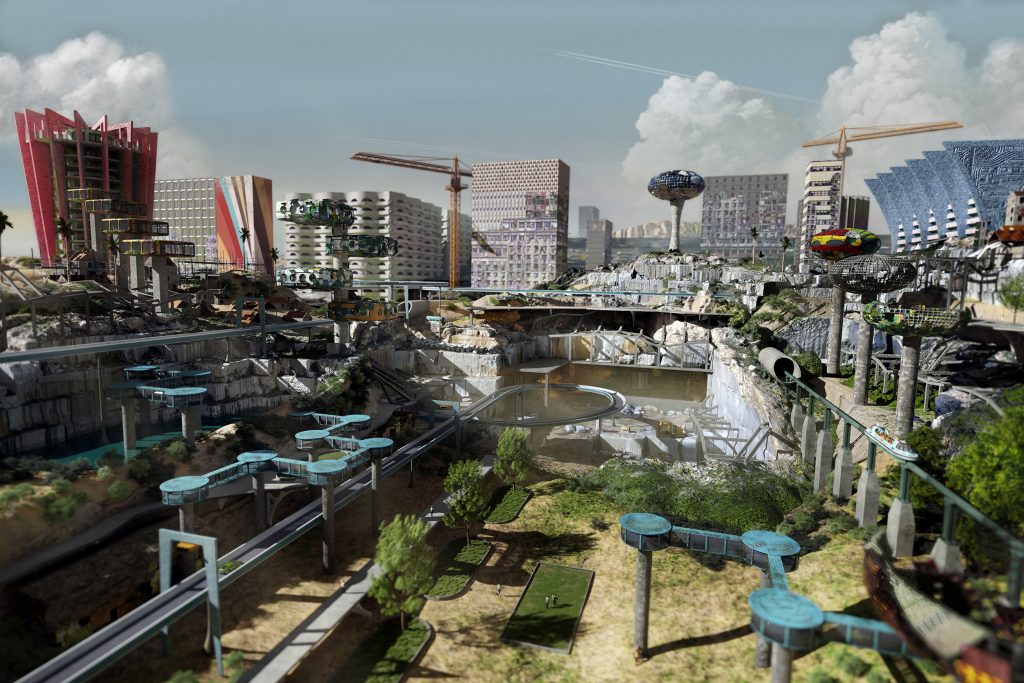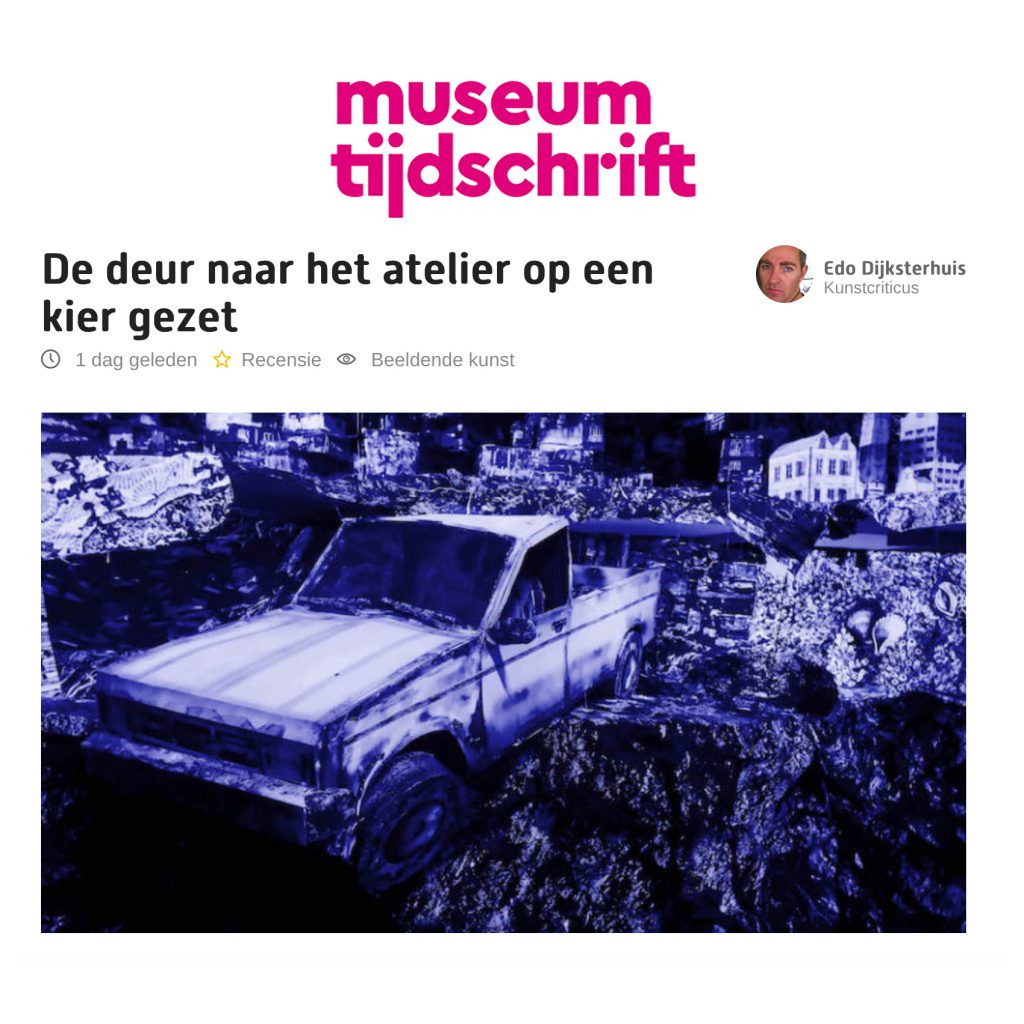JASPER DE BEIJER at galerie dudokdegroot
Galerie dudokdegroot is proud to present
I Have Seen the Future #3 | 2024 | 68 x 93 cm | edition of 7 | c-print
I Have Seen the Future (2024) – Jasper de Beijer
Solo Exhibition September 2024 – Galerie dudokdegroot
‘I Have Seen the Future’ is based on the futurama presentation by the automobile company general motors during the World’s Fair in new york in 1939. Here, the company presented a massive model of a landscape depicting how the united states could look in the future. The model showcased a future world where humanity would have unlimited access to natural resources and complete control over nature.
During the World’s Fair in 1964, a new scale model was presented that was even more exotic and ambitious than the previous one: humans would colonize the moon, explore the deep sea, and create machines that could autonomously build highways in the jungle. In reality, the feasibility of shaping the world turned out differently then expected. It proved to be a utopia, with past visions of the future characterized by manic wishful thinking combined with a painful lack of realism.
The fictional world in ‘ Have Seen the Future’ is one in which the inhabitants are trapped between different visions of the future and reality. These people strive to preserve the illusion at all costs while trying to force reality to resemble their dreams. During this process, they shatter their own reality to reshape their envisioned future, ultimately placing that future in the past. As a result, they are always one step behind, entirely fixated on perpetually creating a new version of the future.
In this project Jasper de Beijer (1973) explores the optimism with which he grew up in the 1970’s and how both he and the world around him increasingly realized that the idea of making the world as they wished was ill-suited to reality. By recreating the escapism of the 1970s, the artist positions himself as someone imposing his subjective vision on reality. This creates a tension where reality must yield to utopian thinking, even though that same utopia proves unworkable in reality.
Jasper de Beijer’s solo exhibition will be on view during the opening of the new gallery season in September 2024.
For more information, images, or a studio visit, please email
info@dudokdegroot.nl or call or message
+31 615475473
Galerie dudokdegroot
Tweede Laurierdwarsstraat 1-3
www.dudokdegroot.nl
JASPER DE BEIJER at dudokdegroot – Foundation
—–Dutch below——
Galerie dudokdegroot is proud to present:
In 2020, Jasper de Beijer (1973) followed a residency at the Pompgemaal in Den Helder with help of the Mondriaan Fund. The estate around the water pumping station has some resemblance of an island, a secluded place over which the world seems to have no influence. The artist experienced his isolation as a form of powerlessness and being lost; his period in residence coincided with the start of the pandemic.
The artist converted the pumping station into a self-designed castle; partly as a physical film set, partly as 3D space in the computer. He then used this computer model to convert the site and building into a classic estate. Because the Pompgemaal and its CGI version (Generated Computer Imaging) fit seamlessly together, De Beijer was able to combine his on-site recordings with his own version of the estate.
The aristocrat tries to maintain the grounds as best as possible, to make contact with the outside world and to keep (imaginary) intruders out. He uses his dated military experience to do patrols and man lookouts.
From his point of view, the estate is one of the last places in Europe that still belong to the old world – and he will do everything he can to preserve this. He tries to make contact with the outside world via a refurbished radio transmitter, but his methods and calling codes have become obsolete.
In the short film Foundation, the white man has become a relic who thinks his own world is crumbling while he tries to maintain an idealized world that has long since disappeared.
Foundation is a prelude to the artist’s first solo at Dudokdegroot Gallery in September 2024, ‘I Have Seen the Future’.
In ‘I Have Seen the Future’, de Beijer extrapolated the idea of ‘Foundation’ and built an imaginary world based on the visions of the future from the 60s and 70s of his youth; Utopian wishful thinking at the time accumulated into a harsh confrontation with the excesses of the emerging consumer society. By clinging to the illusion of a glorious future, the residents of this ideal model society have ended up in a world where they desperately cling to an unworkable utopia that is constantly overtaken by reality.
With special thanks to:
 The Mondriaan Foundation
The Mondriaan Foundation
 Het Amsterdams Fonds voor de Kunst
Het Amsterdams Fonds voor de Kunst
FROM / TO
8 – 16 March 2024
- ADDRESS
Galerie dudokdegroot
Tweede Laurierdwarsstraat 1–3, 1016 RA Amsterdam
0031615475473 - Website
- OPENING HOURS
- Wednesday 13:00—18:00
Thursday 13:00—18:00
Friday 13:00—18:00
Saturday 13:00—18:00
Dutch version—————————————————————————————————————————————
Galerie dudokdegroot presenteert:
In 2020 volgde Jasper de Beijer (1973) via het Mondriaanfonds een residentie in het Pompgemaal in Den Helder. Het landgoed rond het gemaal heeft iets van een eiland, een afgeschermde plek waar de wereld geen invloed op lijkt te hebben. Deze isolatie voelde voor de kunstenaar aan als een vorm van machteloosheid en verlorenheid; zijn periode in de residentie viel samen met de start van de pandemie. De kunstenaar bouwde het gemaal om tot een zelf ontworpen kasteel; deels als fysieke filmset, deels als 3D ruimte in de computer. Vervolgens heeft hij dit computermodel gebruikt om het terrein en gebouw om te bouwen in een klassiek landgoed. Omdat het Pompgemaal en zijn CGI versie (Generated Computer Imaging) ervan naadloos op elkaar pasten, kon De Beijer zijn ter plekke gemaakte opnamen combineren met zijn eigen versie van het landgoed. De aristocraat probeert het terrein zo goed mogelijk te onderhouden, contact te leggen met de buitenwereld en (imaginaire) indringers buiten te houden. Hij gebruikt zijn gedateerde militaire ervaring om wachtrondes te lopen en uitkijkposten te bemannen.
Vanuit zijn optiek is het landgoed nog één van de laatste stukjes Europa die nog bij de oude wereld hoort en hij zal er alles aan doen om dit te behouden. Hij probeert via een opgeknapte radiozender contact te leggen met de buitenwereld maar zijn methodes en oproepcodes worden niet meer gebruikt.
In de korte film Foundation is de witte man een reliek geworden die denkt dat zijn eigen wereld afbrokkelt terwijl hij een geïdealiseerde wereld in stand probeert te houden die allang is verdwenen.
Foundation is een opmaat naar de eerste solo van de kunstenaar bij galerie dudokdegroot in september 2024, ‘I Have Seen the Future’.
In ‘I Have Seen the Future’ heeft de Beijer bovenstaand idee geëxtrapoleerd en een imaginaire wereld gebouwd die gebaseerd op de toekomstvisies uit de jaren ’60 en ’70 van zijn jeugd; utopisch wensdenken ging destijds een harde confrontatie aan met de uitwassen van de opkomende consumptiemaatschappij. Door zich aan de illusie van een glorieuze toekomst vast te houden zijn de bewoners van deze ideale modelsamenleving in een wereld terechtgekomen waar ze zich wanhopig vastklampen aan een onwerkbare utopie die voortdurend wordt ingehaald door de werkelijkheid.
DATUM 8 t/m 16 maart 2024
- ADRES
Galerie dudokdegroot
Tweede Laurierdwarsstraat 1–3, 1016 RA Amsterdam
0031615475473 - Website
- OPENINGSTIJDEN
Woensdag 13:00—18:00
Donderdag 13:00—18:00
Vrijdag 13:00—18:00
Zaterdag 13:00—18:00
ADMISSION
Free admission
For a personal appointment or more information, call 0031615475473 or email info@dudokdegroot.nl
JASPER DE BEIJER at DUDOK DE GROOT
Galerie dudokdegroot kondigt met veel plezier onze nieuwe samenwerking aan met kunstenaar Jasper de Beijer (English below)
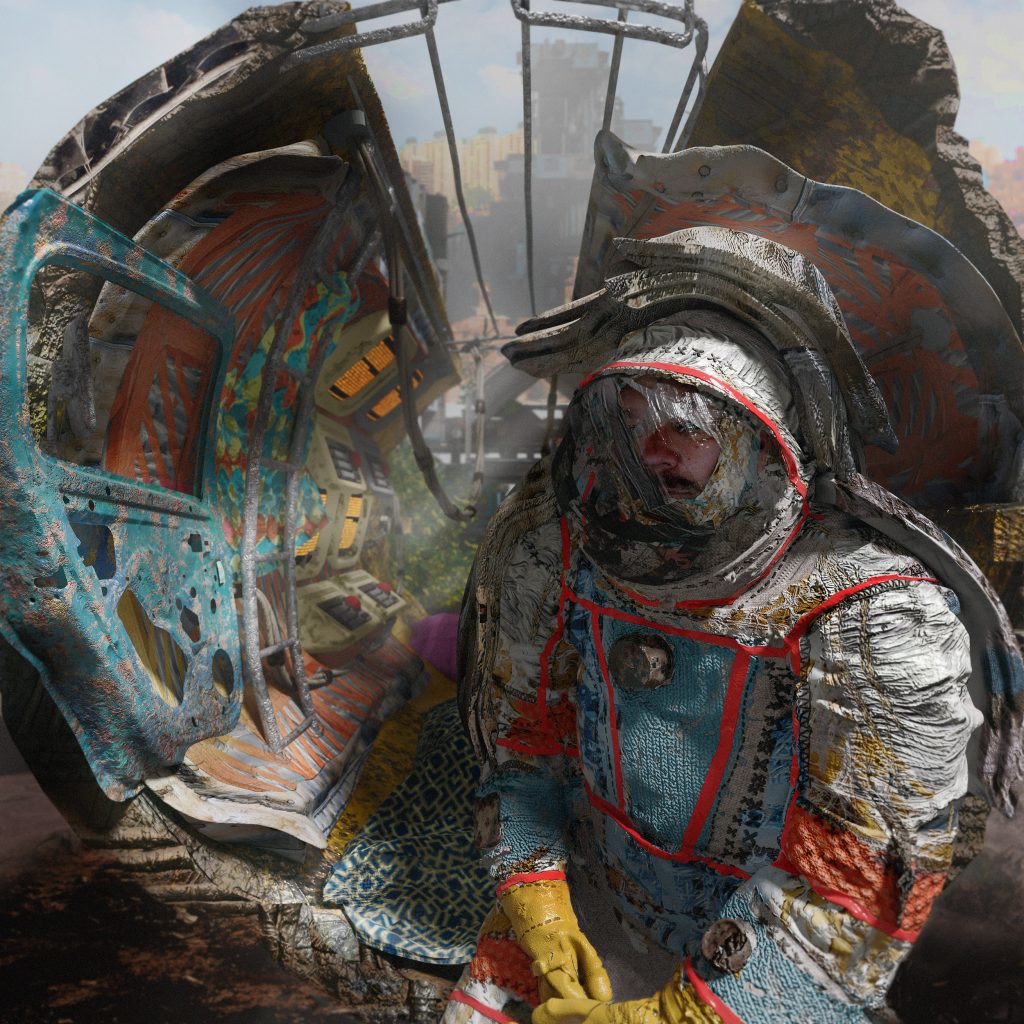
I Have Seen the Future | 2023 | 40 x 40 cm | Epson Baryta Print | Edition of 15
Voor een tentoonstelling bij Dudokdegroot werkt De Beijer momenteel aan een nieuw project: I have seen the Future, gebaseerd op de Futurama presentatie van General Motors tijdens de World’s Fair in New York in 1939. Op deze beurs stond een gebouw van GM met een enorme maquette van een landschap dat toonde hoe de VS er in de toekomst uit zou gaan zien: de automotive world (ontworpen door Norman Bel Geddes). Deze utopie van onbegrensde mogelijkheden laat een toekomstige wereld zien waarin de mensheid alle natuurlijke hulpmiddelen onbeperkt tot zijn beschikking heeft en een volledige controle heeft over de natuur. Als kind groeide de Beijer op in dit positivisme en had het idee in een wereld te leven waarin onbegrensde dingen mogelijk zijn: het redden van de aarde van een milieuramp, het einde aan oorlogen, racisme en ander onrecht. De Beijer schept voor I have seen the Future een eigen futurama waarin fotografie, tekenen, film en sculptuur samenkomen.
SPECIAL EDITION: Als primeur van I have seen the Future presenteert Jasper de Beijer bovenstaande Special Edition. Dit werk is vanaf zaterdag 23 september te zien en te koop in de galerie. Voor meer informatie stuur een mail aan: info@dudokdegroot.nl
—————————————————————————————————————————-
Dudokdegroot is pleased to announce our new collaboration with artist Jasper de Beijer.
De Beijer is currently working on a new project for an exhibition at Dudokdegroot: I have seen the Future, based on the Futurama presentation by General Motors during the World’s Fair in New York in 1939. At this fair there was a GM building with an enormous model of a landscape that showed what the US would look like in the future: the automotive world (designed by Norman Bel Geddes). This utopia of limitless possibilities shows a future world in which humanity has unlimited access to all natural resources and complete control over nature. As a child, De Beijer grew up in this positivism and had the idea of living in a world in which unlimited things are possible: saving the earth from an environmental disaster, the end of wars, racism and other injustices. For I have seen the Future, De Beijer creates his own futurama in which photography, drawing, film and sculpture come together.
SPECIAL EDITION: As a scoop of I have seen the Future, Jasper de Beijer presents the above Special Edition. This work can be seen and purchased in the gallery from Saturday September 23. For more information, send an email to: info@dudokdegroot.nl
Jasper de Beijer at ARTWEEKS@AKARETLER
Within the scope of Istanbul’s cultural and artistic activities, “Artweeks@ Akaretler”, which has a special place among art lovers, with its seventh edition, between 2nd and 13th of November; With the organization of Bilgili Holding, it brings together the works of important artists with art lovers once again in Akaretler.
Within the scope of the event, The Empire Project will be at number 55 in Sıraevler Akaretler; Banu Birecikligil features a selection from Jasper de Beijer, Lale Tara, Mehmet Güleryüz, Memo Tembelçizer, Merve Tuna and Özlem Ünlü.
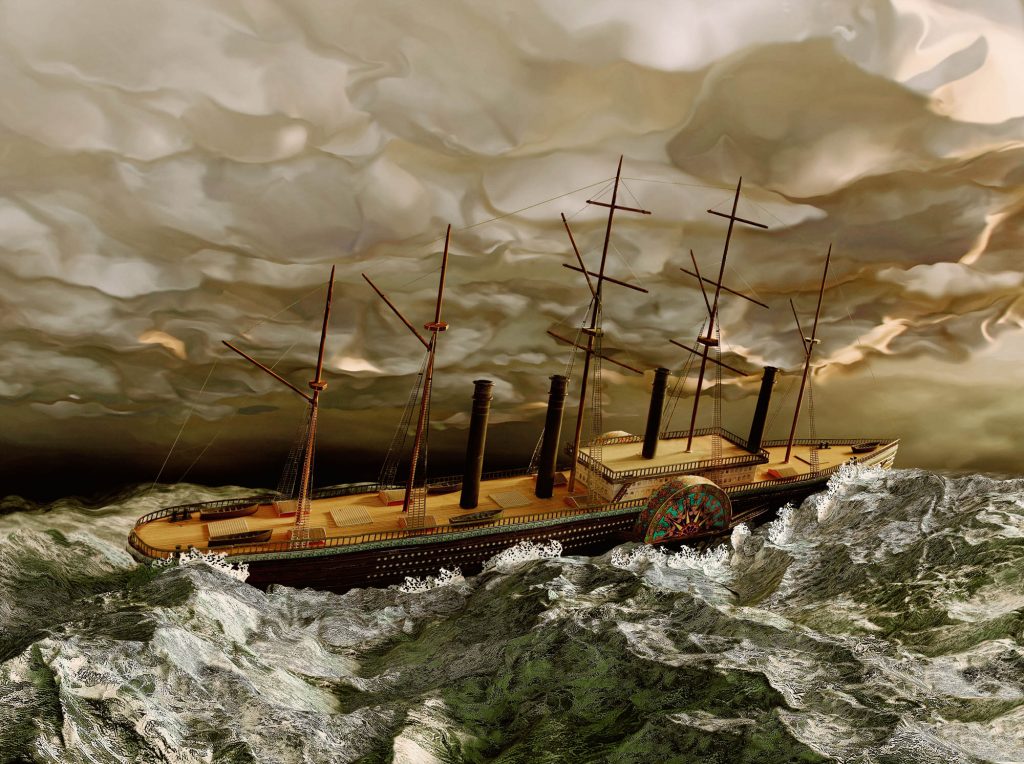
Türkçe olarak:
İstanbul’un kültürel ve sanatsal etkinlikleri kapsamında sanatseverlerde kendine özel bir yer edinen “Artweeks@Akaretler” yedinci edisyonuyla 2 – 13 Kasım tarihleri arasında; Bilgili Holding organizasyonuyla, önemli sanatçıların eserlerini yeniden Akaretler’de sanatseverlerle buluşturuyor.
Etkinlik kapsamında Sıraevler Akaretler 55 Numarada The Empire Project; Banu Birecikligil, Jasper de Beijer, Lale Tara, Mehmet Güleryüz, Memo Tembelçizer, Merve Tuna ve Özlem Ünlü’den bir seçki ile yer alıyor
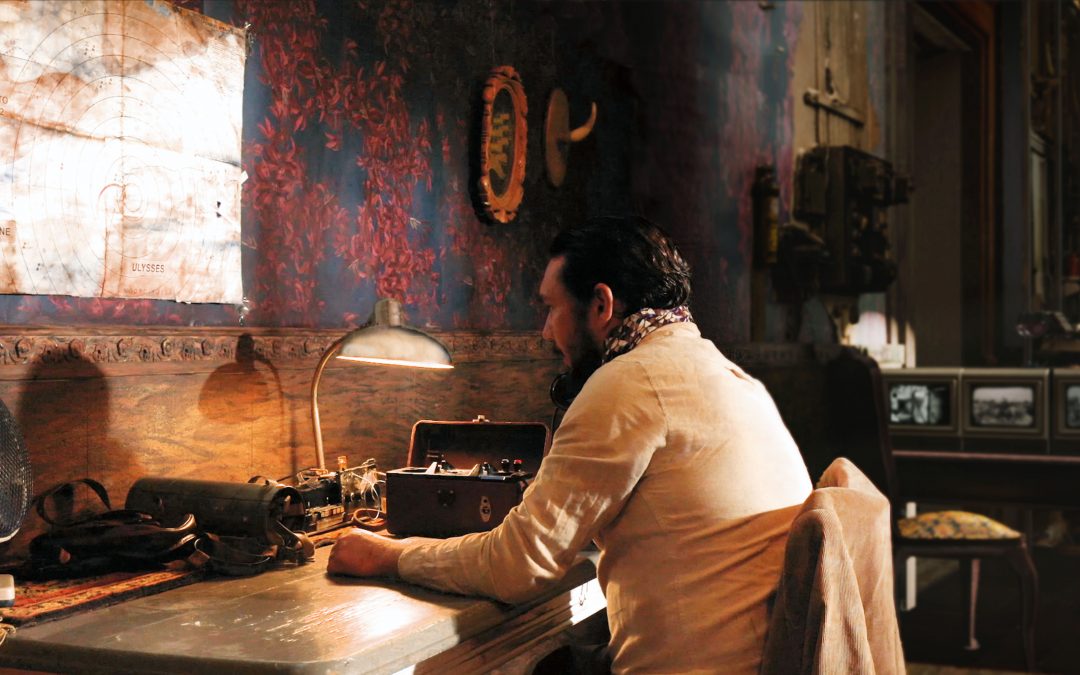
Jasper de Beijer – Foundation (Work in progress)
Press release Foundation (2020 – 2023) Dutch Below
In 2020 Jasper de Beijer followed a Mondriaan Fund residency at the Pompgemaal in Den Helder, the Netherlands. The artist used his working period to convert the old water pumping station into a self-designed castle; partly as a film set, partly as a 3D computer model. In the months following the residency, de Beijer has been working on a complete fantasy world that plays the leading role in this project. The story of this estate is told in a short film.
The estate around the pumping station resembles an island, a shielded place where the world seems to have no influence. This isolation amplified his feeling of powerlessness and lostness; his residence period coincided with the start of the Corona epidemic. That isolation, combined with his half-baked attempts to manage and control the building and grounds gave Jasper the artistic space to assume the role of lord of the castle – a caretaker who tries to preserve the grandeur of the castle and estate.
During extensive research into his own family tree, the artist found out that a relative was a baron who managed a country house 150 years ago. He was the first and last aristocrat of the family, his branch had no children. The character of this aristocrat served as the starting point for his character in the project.
De Beijer scanned the estate into the computer in 3D with a drone and used this computer model to adjust the terrain and building; a 19th century garden, hunting grounds, a coach house – everything needed to give the estate the right character.
Because the actual location and the computer version fit together seamlessly, De Beijer was able to combine film recordings made on set and location with his own 3D version of the building and grounds.
The protagonist tries to maintain the grounds as well as possible, to establish contact with the outside world and to keep out imaginary intruders. The aristocrat patrols guards, maintains fences, mans lookouts – and uses his limited military experience to make the most of it.
For the caretaker, the estate is still one of the pieces of Europe that belongs to the old world, and he will do everything he can to keep it that way. He tries to make contact with others like him in Europe via a refurbished radio transmitter, but his methods and call codes are outdated. In that sense, this project is almost the opposite of Jasper’s very first project in 2004, Buitenpost. There, the residents of the site kept control of foreign territory through their authority. Here the white man is a relic, thinking his own world is crumbling as he tries to preserve something that is long gone.
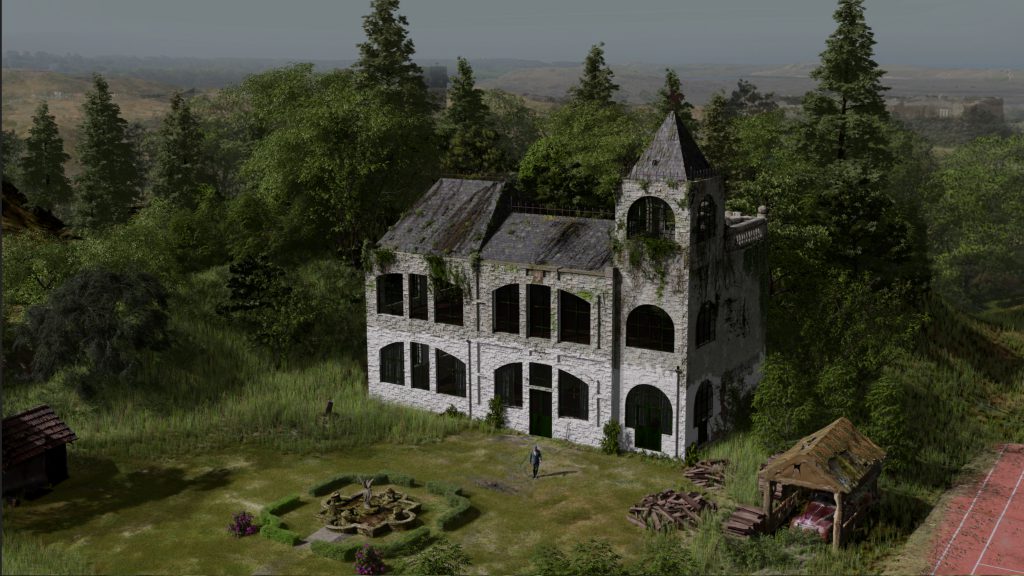
==================================================================
Persbericht Foundation (2020 – 2023)
In 2020 heeft Jasper de Beijer via het Mondriaanfonds een residentie in het Pompgemaal in Den Helder gevolgd. De kunstenaar heeft zijn werkperiode gebruikt om het oude watergemaal om te bouwen tot een zelf ontworpen kasteel; deels als filmset, deels als ruimte in de computer. In de maanden na de residentie is de Beijer bezig geweest om een volledige fantasiewereld op te bouwen die in dit project de hoofdrol speelt. In een korte film wordt het verhaal van dit landgoed verteld.
Het landgoed rond het gemaal heeft iets van een eiland, een afgeschermde plek waar de wereld geen invloed op lijkt te hebben. Deze isolatie voelde voor de kunstenaar ook aan als een vorm van machteloosheid en verlorenheid; zijn periode in de residentie viel samen met de start van de Corona epidemie.
Die isolatie, gecombineerd met zijn halfbakken pogingen om het gebouw en terrein te beheren en onder controle te krijgen gaf Jasper de artristieke ruimte om in de rol van kasteelheer te kruipen – een beheerder die de grandeur van het kasteel en landgoed probeert te behouden.
Tijdens uitgebreide research naar zijn eigen stamboom kwam de kunstenaar er achter dat een familielid baron is geweest die 150 jaar geleden een landhuis beheerde. Hij was de eerste en de laatste aristocraat van de familie, zijn tak kreeg geen kinderen. Het personage van deze aristocraat diende als uitgangspunt voor zijn personage.
Met een drone heeft de Beijer het landgoed in de computer in 3D ingescand en dit computermodel gebruikt om het terrein en gebouw aan te passen; een 19e eeuwse tuin, een jachtgebied, een koetshuis – alles wat nodig is om het landgoed het juiste karakter te geven.
Omdat de werkelijke plek en de computerversie ervan naadloos op elkaar passen kon De Beijer ter plekke gemaakte filmopnamen combineren met zijn eigen versie van het gebouw en terrein. De hoofdrolspeler probeert het terrein zo goed mogelijk te onderhouden, contact te leggen met de buitenwereld en imaginaire indringers buiten te houden. De aristocraat loopt wachtrondes, onderhoudt hekken, bemant uitkijkposten – en gebruikt zijn beperkte militaire ervaring om er het beste van te maken.
Voor de beheerder is het landgoed nog één van de stukjes Europa die bij de oude wereld horen, en hij zal er alles aan doen om dit zo te houden. Hij probeert via een opgeknapte radiozender contact te leggen met lotgenoten in Europa, maar zijn methodes en oproepcodes zijn verouderd. In die zin is dit project bijna het tegenovergestelde van Jasper’s allereerste project in 2004, Buitenpost. Daar hielden de bewoners van het terrein controle op vreemd gebied door hun autoriteit.
Hier is de witte man een reliek, die denkt dat zijn eigen wereld afbrokkelt terwijl hij iets probeert te behouden dat allang is verdwenen.
De Telegraaf, “Jasper de Beijer graaft in Museum Rijswijk eigen geschiedenis op,” by Paola van de Velde
English (Dutch version below):

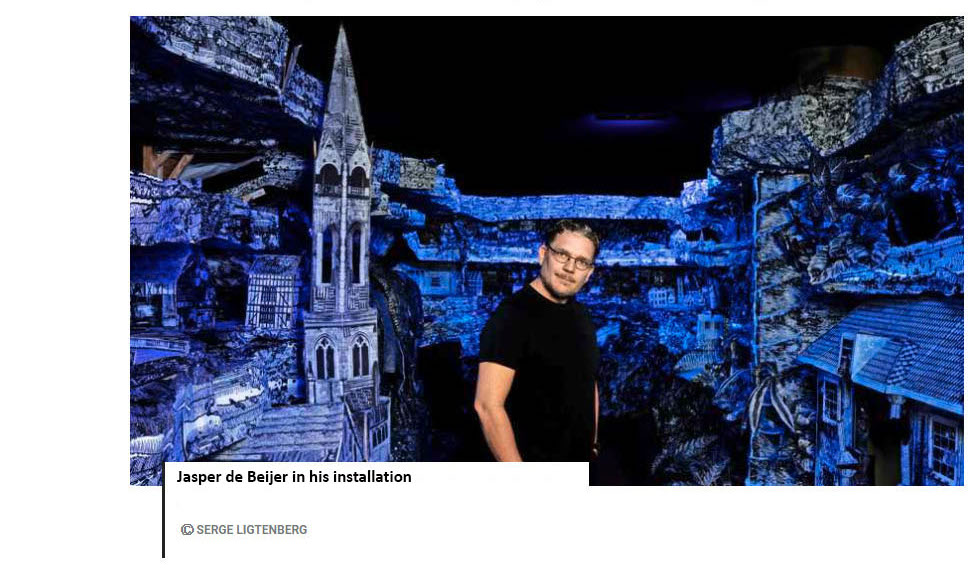

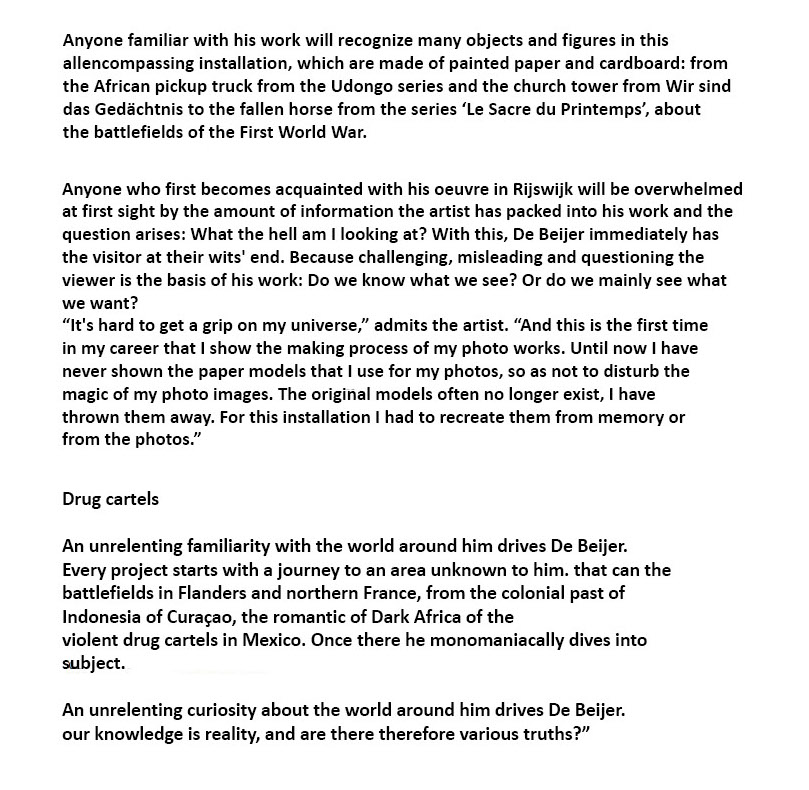
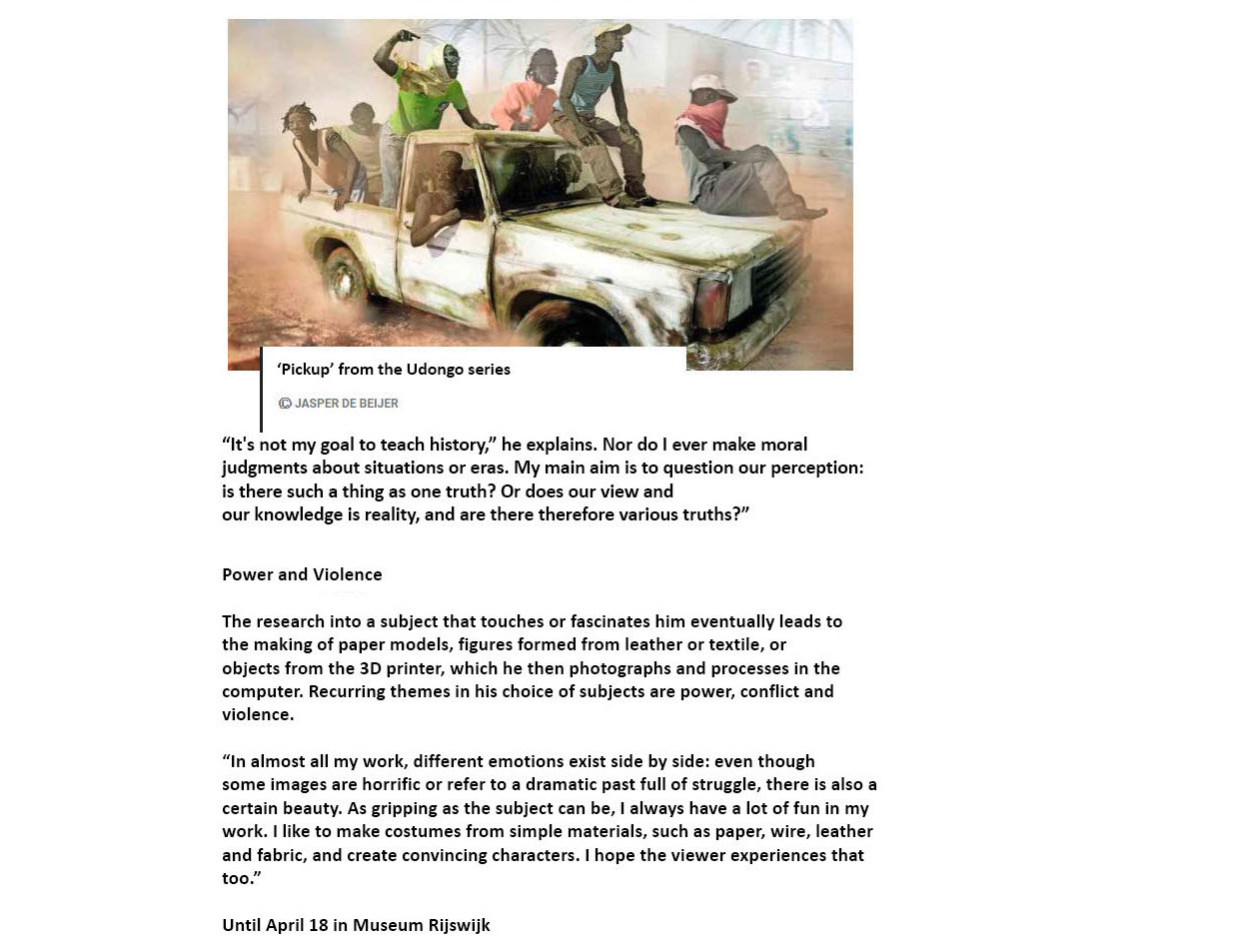
Dutch:
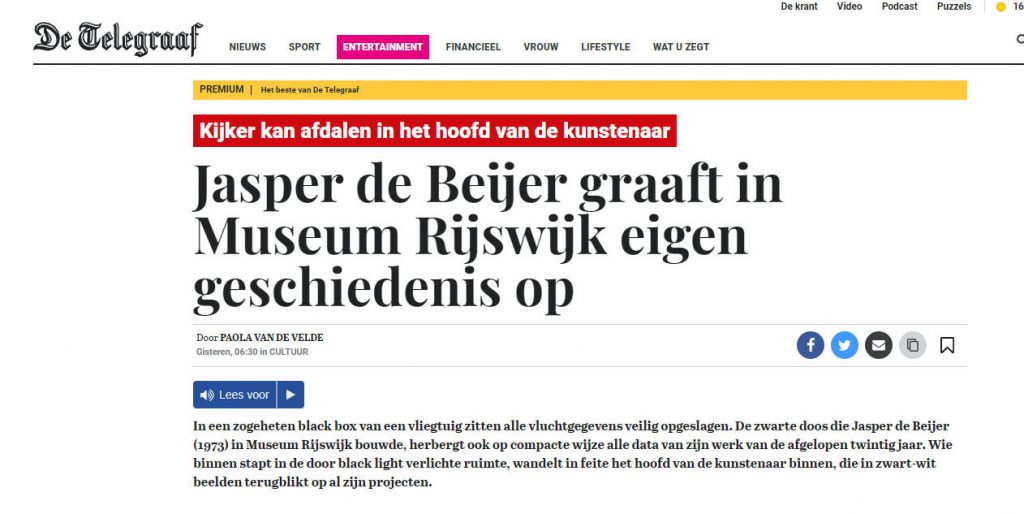



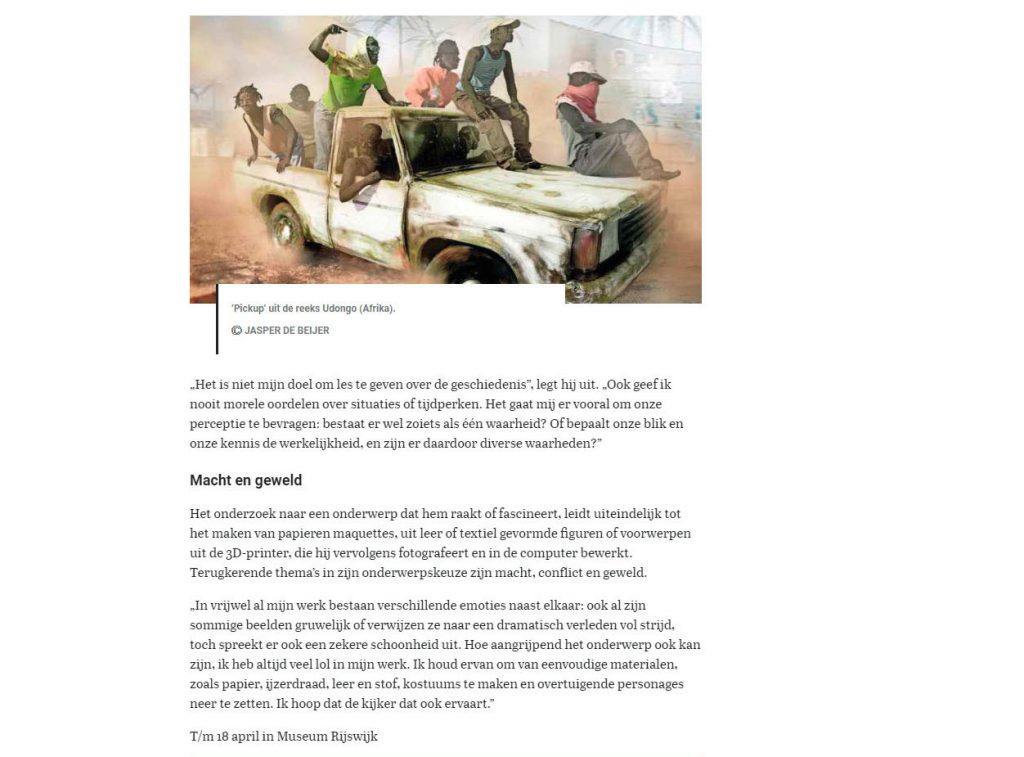
Den Haag Centraal, “Retrospectief in Museum Rijswijk, De donkere kamer van Jasper de Beijer”, by Hendrik van Leeuwen

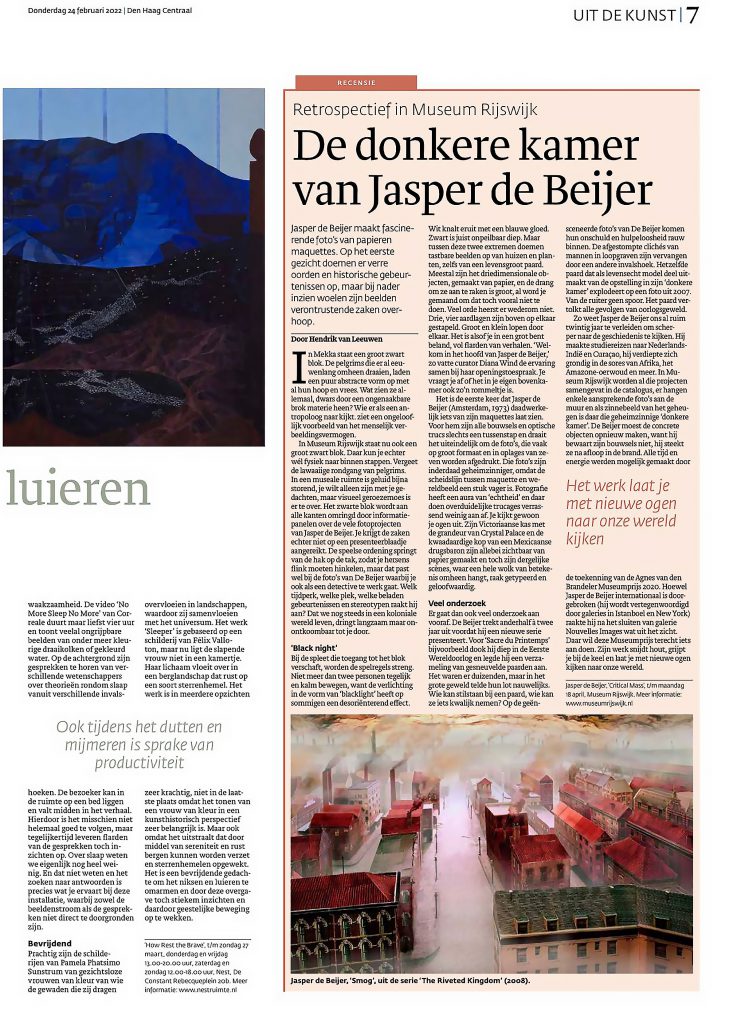
Museumtijdschrift, “Behind the Scenes at… Museum Rijswijk & Jasper de Beijer”
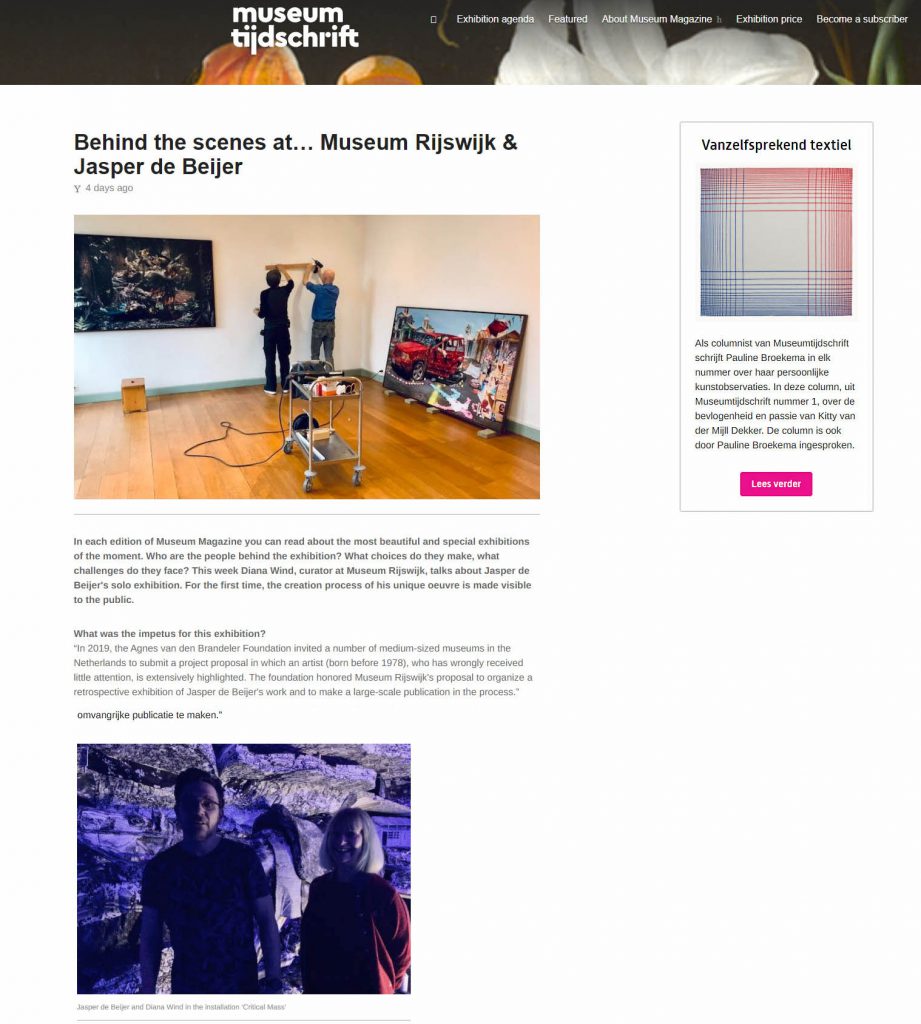
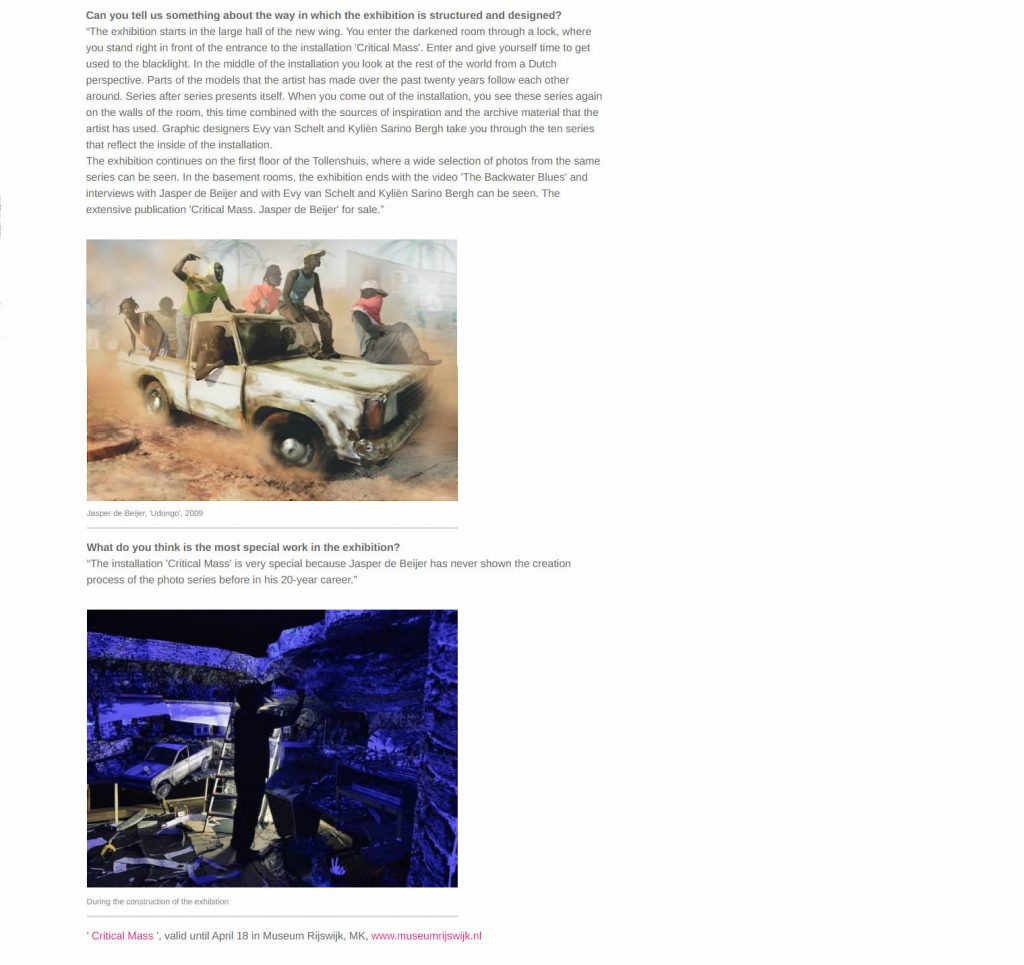
In Dutch below:

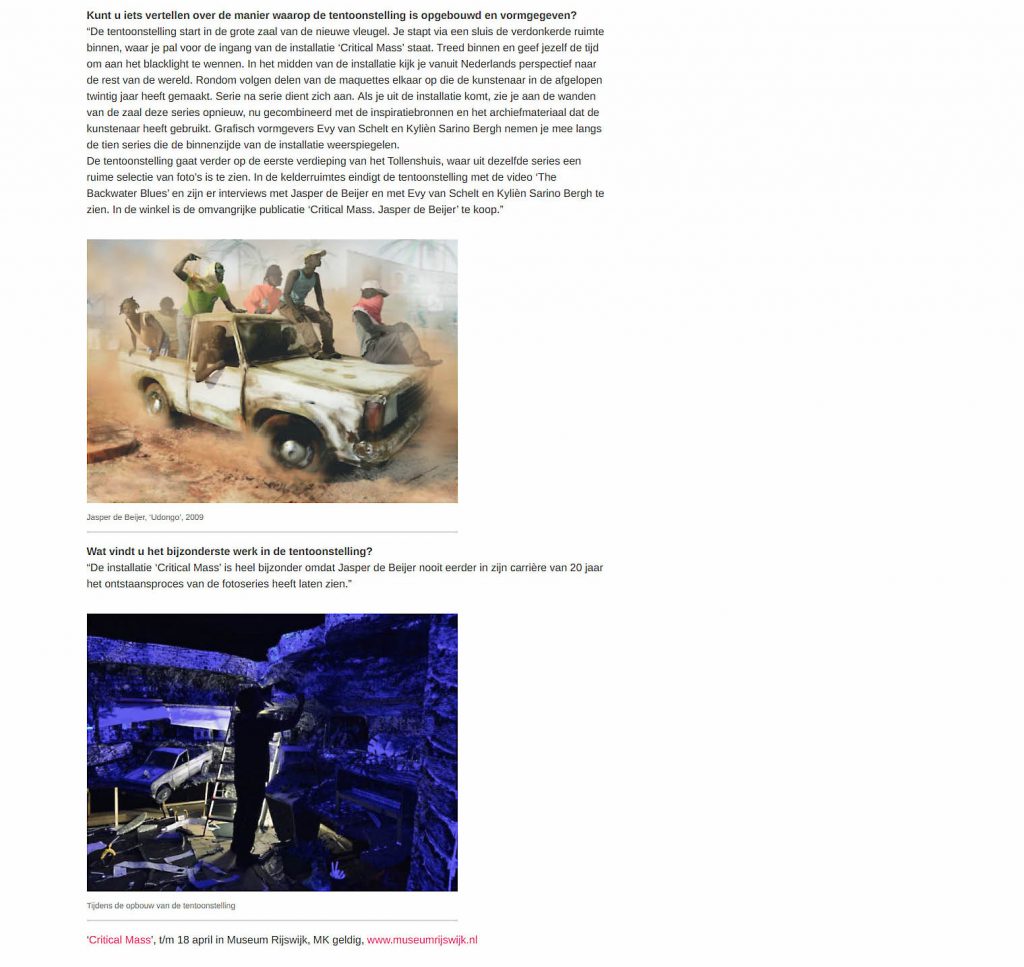
Museumtijdschrift, “De deur naar het atelier op een kier gezet”, by Edo Dijksterhuis
In de foto’s van Jasper de Beijer storten vliegtuigen neer in de Amazone, exploderen paarden en lopen figuren rond zonder hoofd. In Museum Rijswijk laat de kunstenaar nu voor het eerst zien hoe hij dat doet.
Hoe heeft de kunstenaar dat gemaakt? Het is een geliefde en veelgehoorde vraag onder museumbezoekers. Maar kunstenaars hebben er over het algemeen een hekel aan. Ze voelen zich door die vraag gereduceerd tot knutselaars en zijn bang dat nadruk op het ambachtelijke deel van hun werk het zicht ontneemt op de bedoeling en de betekenis ervan. Daar hebben ze deels gelijk in – alleen maar kijken naar de techniek kan kunst platslaan – maar hoe een werk eruitziet, maakt het juist ‘beeldende’ kunst.
Jasper de Beijer verzet zich niet langer tegen de hoe-vraag. In de overzichtstentoonstelling ‘Critical Mass’ in Museum Rijswijk heeft hij die vraag zelfs omarmd. En dat is opmerkelijk, want in de twintig jaar dat hij nu actief is als kunstenaar heeft hij de maquettes, installaties en decorstukken die hij gebruikt voor zijn foto’s altijd vernietigd na de shoot. De foto’s zijn voor hem de kunstwerken; alles wat hij ervoor nodig heeft is gereedschap – en gereedschap stel je niet tentoon. Tot nu dan. In ‘Critical Mass’ zet De Beijer de deur naar zijn atelier op een kier en laat hij kijkers toe in zijn maakproces.
Cashewnoot en tandenstoker
In de grote benedenzaal van Museum Rijswijk is op de wanden een soort archeologische tijdlijn aangebracht waarop verschillende lagen in De Beijers werken worden blootgelegd. Met veel plaatjes en korte teksten wordt verteld hoe de kunstenaar honderden foto’s van een gebouw of monument in de computer verwerkt tot 3D-model. Maar ook hoe hij van een cashewnoot en een tandenstoker een ontkiemende palmboom maakt. De Beijer trekt volledige steden op uit karton en speelt zelf met maskers en kostuums de personages in zijn verhalen.
Te zien zijn ook afbeeldingen van de antiquarische boeken en tijdschriften waar de kunstenaar graag uit put. De Beijers verhalen spelen zich af in het Braziliaanse oerwoud, op een zeventiende-eeuwse Caraïbische plantage of in de loopgraven van de Eerste Wereldoorlog. Het startpunt is altijd de werkelijkheid, maar die wordt een kwartslag gekanteld en bevolkt door ‘larger than life’ figuren, van een West-Afrikaanse worstelaar tot een melancholieke koloniaal.
Midden in de zaal met al die informatie staat een donker kamertje met een diorama. Hier komen allerlei figuren en decorstukken uit verschillende werken bij elkaar. Maar het is veel meer dan een collage die door het gebruik van blacklight sprookjesachtig oplicht. De Beijer waagt hier een stap in de richting van beeldhouwkunst, waardoor zijn werk een ruimtelijkheid krijgt die het hiervoor niet had. Het is alsof je een foto van De Beijer binnenstapt.
Mexicaanse drugsbaronnen
Op de bovenverdieping en in de kelder wordt een mooie dwarsdoorsnede getoond van De Beijers oeuvre. Wie de jaartallen op de tekstbordjes leest, ziet hoe de verhalen en hun uitwerking sinds het redelijk ingetogen ‘Buitenpost’ (2004) steeds exuberanter zijn geworden. Toppunt is ‘Marabunta’ (2012), dat zich afspeelt in de barokke en macabere wereld van Mexicaanse drugbaronnen.
‘Critical Mass’ is een voorbeeldige tentoonstelling die echt iets toevoegt aan het begrip van De Beijers werk, ook voor wie het al goed kent. Het enige wat beter zou kunnen is de bewegwijzering. Als de bezoeker eerst langs de fotowerken boven wordt geleid, borrelt de gedachte ‘hoe heeft hij dat gemaakt?’ vanzelf op en valt de uitleg op de begane grond in vruchtbare aarde. De waardering voor wat je vlak daarvoor hebt gezien, neemt dan met terugwerkende kracht toe.
‘Jasper de Beijer: Critical Mass’, t/m 18 april in Museum Rijswijk, MK geldig, www.museumrijswijk.nl
Hoofdbeeld: installatieoverzicht van ‘Critical Mass’, 2020-21, papier op karton en hout, canvas, blacklight.
Full article here.
Arts Talk Magazine.NL, “Jasper de Beijer’s CRITICAL MASS at Museum Rijswijk”, by Michael Hasted
I think the one word that would describe the work of Dutch artist Jasper de Beijer is eclectic. He is an artistic scavenger, a collector par excellence. The accumulations and focus of his interest range from the Battle of Verdun in the First World War to Isambard Kingdom Brunel, from Mexican drug cartels to Dutch colonialism. He collects photos, press cuttings, old stereo cards and any other ephemera he can find on his chosen subject. He then sets to work bringing them all together to make his art, using models and/or photographs of the models or figures in exotic costumes and make-up.
His current exhibition shows his new installation, Critical Mass, surrounded on the gallery walls by examples of his source material. The installation is sited in a black box in the centre of the gallery. The darkened, predominantly blue space represents a hole which we wander through, surrounded by weird and wonderful tableaux. The effect is part shrine, part grotto and part model railway layout without the trains. There are houses, a church, a jungle, mountains, a pick-up truck and a horse, all made of paper and cardboard. The result is like a Technicolor avalanche or the set for a TV puppet show lit by black light with only the white paper visible. The work was made specifically for Museum Rijswijk and is a culmination of the artist’s work over the past two decades. It’s one of those things where no matter how long you look at it, how many times you return, you will always find something new.
The exhibition was made possible by the Agnes van den Brandeler Museum Prize. In 2019 the Agnes van den Brandeler Foundation invited several medium-sized museums in the Netherlands to submit proposals for exhibitions and accompanying publications that would highlight the work of a highly talented Dutch artist who has not had enough exposure in Dutch museums over the past years. The Foundation chose the proposal by Museum Rijswijk for a retrospective exhibition of Jasper de Beijer’s work and the comprehensive publication on his oeuvre.
As I have said before, for a smallish museum in a smallish town, Museum Rijswijk punches well above its weight. In addition to its two biennales – Paper and Textile – of international standard it mounts exhibitions which are original and often quirky. A visit to Museum Rijswijk will always be rewarding and none more so than for Jasper de Beijer’s Critical Mass.
Michael Hasted
6 February 2022
Critical Mass runs at Museum Rijswijk until 18th April.
Link to the article here.
